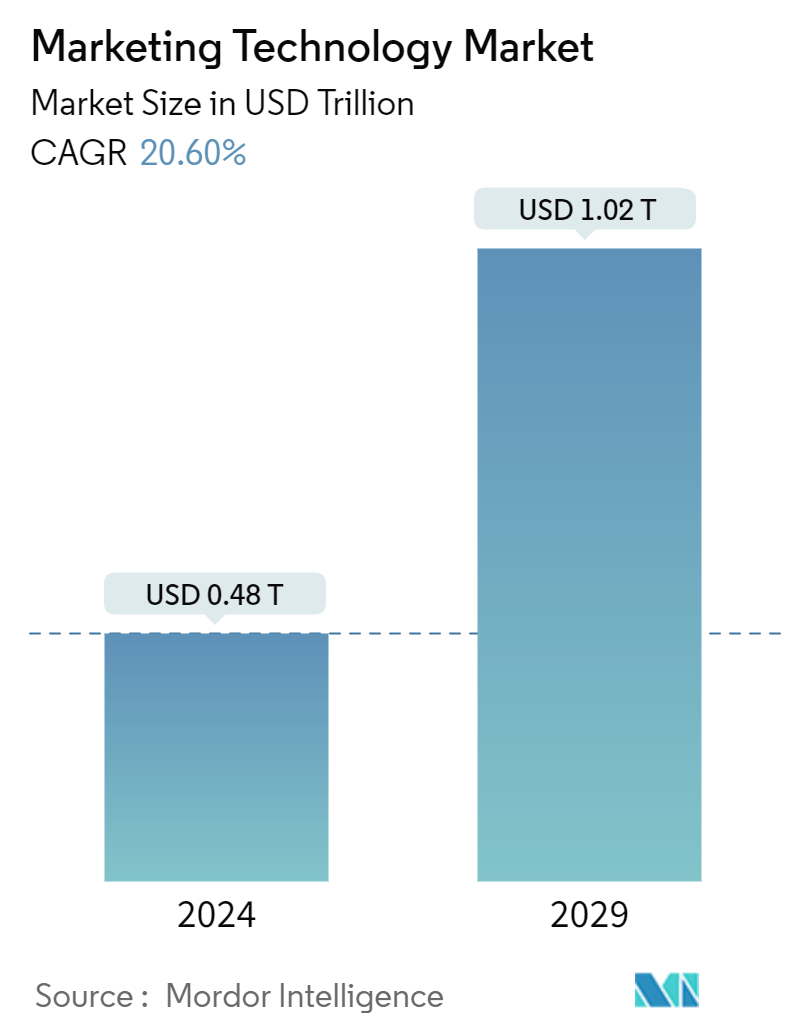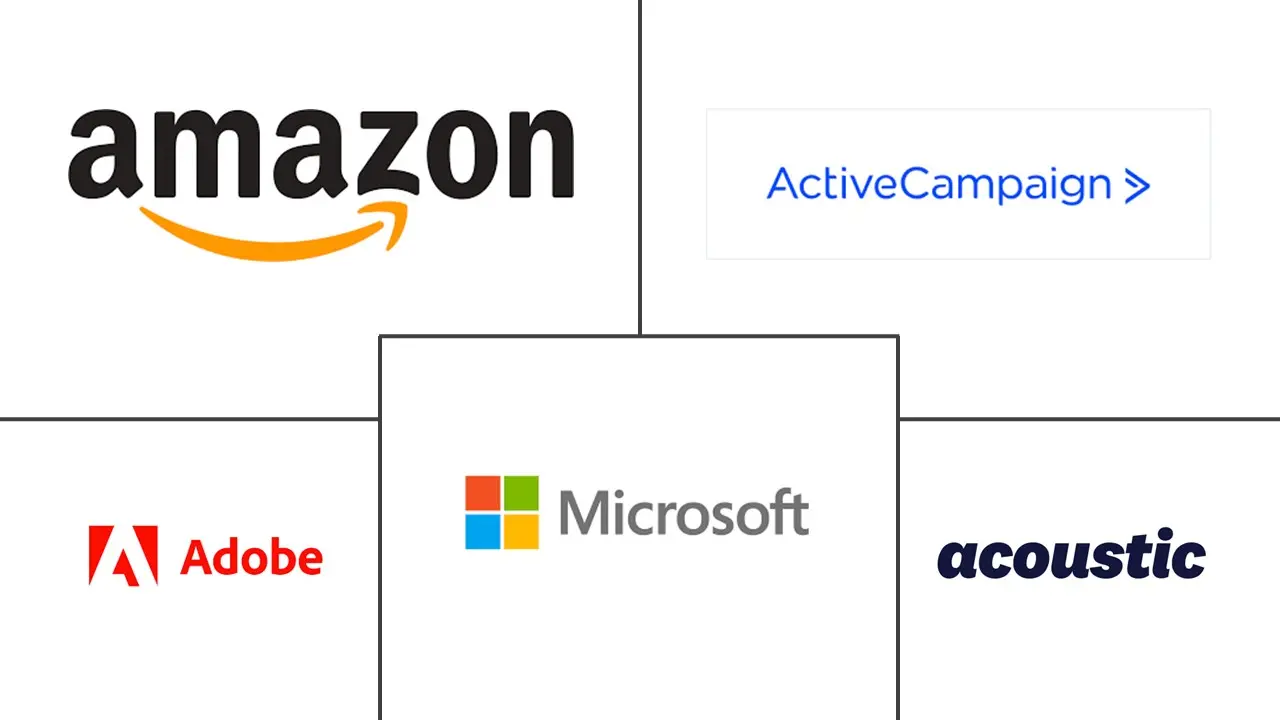Market Size of Industrying Technology Market

| Study Period | 2019 - 2029 |
| Market Size (2024) | USD 0.48 Trillion |
| Market Size (2029) | USD 1.02 Trillion |
| CAGR (2024 - 2029) | 20.60 % |
| Fastest Growing Market | Asia Pacific |
| Largest Market | North America |
| Market Concentration | Medium |
Major Players
*Disclaimer: Major Players sorted in no particular order |
Marketing Technology Market Analysis
The Marketing Technology Market size is estimated at USD 0.48 trillion in 2024, and is expected to reach USD 1.02 trillion by 2029, growing at a CAGR of 20.60% during the forecast period (2024-2029).
Technology has changed how people worldwide receive, interpret and respond to information. Technology has become more and more of a factor in marketing. The marketing environment is continuously evolving and growing due to advances in MarTech, making it easier for companies to deal with the constant fragmentation and customer journeys. In addition, marketing technology must consider all aspects of the execution requirements. It makes it possible for marketers to scale their campaigns holistically.
- Startups increasingly utilize augmented and virtual reality (AR/VR) to deliver an immersive consumer experience and increase engagement. These solutions equip marketers with measurable engagement options, such as geo-fenced details for location-specific targeting, virtual events, and storefronts. XR and technologies such as drones, interactive billboards, and holograms advance experiential and guerilla marketing activities.
- Startups are building digital-out-of-home (DOOH) advertising solutions to display dynamic ads and measure real-time returns on advertisement spend (ROAS). Companies also use hybrid events to reach their worldwide audience and measure marketing attribution. Further, ad campaigns with 360-degree videos, holographic projections, and drone light shows are the other applications of XR to capture user attention.
- Further, live, and non-live streaming on social media for product sales, reviews, and consumer interaction continue to increase business revenue opportunities. Such platforms offer a profitable alternative to paid ads and enable consent-based data collection from users. Selling products while live streaming remains the top subtrend in social commerce, followed by vlogs and short-form video content. Additionally, businesses and marketing agencies utilize these means to deliver brand messages, create new trends, and improve customer engagement. Additionally, virtual social media influencers are replacing expensive celebrity influencers to promote brands and products.
- For instance, Polish startup inStreamly provides a streamer management platform that connects brands and streaming platforms with micro-streamers. It allows brands to run sponsored content and display campaigns embedded in live streams of several micro-influencers with highly engaged communities.
- The platform provides live statistics per campaign per streamer for campaign views, click-through rates (CTRs), and costs per click and acquisition (CPC/CPA). This allows brands to reach their target audience non-invasively and build trust among Gen Z users.
- On the flip side, engagement with clients is a significant challenge for all companies. Marketing Automation Software growth has been hampered by legacy systems and the reluctance of firms to digitize. As per Automizy, the survey of 130 business experts suggested that the main challenge of the marketing and advertising industry was integration. Approximately 25% of respondents mentioned it. It added that even with all the integrations provided by marketing automation vendors and solutions, the challenge remains to set up integrations between different platforms and tools.
Marketing Technology Industry Segmentation
Marketing technology, also known as MarTech, defines a range of tools and software that assist in achieving marketing objectives or goals. When a marketing group utilizes a grouping of marketing technologies, this is known as its marketing technology stack. MarTech has evolved into a staple in digital marketing campaigns and can also be used to optimize marketing measures across any marketing channel.
The marketing technology market is segmented by product (social media tools, content marketing tools, rich media tools, automation tools, data and analytics tools, sales enablement tools), by application (IT and telecommunication, retail, and e-commerce, healthcare, media and entertainment, sports and events, BFSI), by geography (North America, Europe, Asia Pacific, Latin America, Middle East, and Africa).
The market sizes and forecasts are provided in terms of value (USD) for all the above segments.
| By Product | |
| Social Media Tools | |
| Content Marketing Tools | |
| Rich Media Tool | |
| Automation Tool | |
| Data and Analytics Tools | |
| Sales Enablement Tools |
| By Application | |
| IT and Telecommunication | |
| Retail and E-commerce | |
| Healthcare | |
| Media and Entertainment | |
| Sports and Events | |
| BFSI | |
| Other Applications |
| By Geography | |
| North America | |
| Europe | |
| Asia | |
| Australia and New Zealand | |
| Latin America | |
| Middle East and Africa |
Marketing Technology Market Size Summary
The marketing technology market is experiencing significant growth, driven by the rapid evolution of digital tools and platforms that enhance how businesses engage with consumers. This sector is characterized by the integration of advanced technologies such as augmented and virtual reality, drones, and interactive billboards, which are increasingly used to create immersive consumer experiences and improve engagement. Startups are leveraging these technologies to develop innovative solutions like digital-out-of-home advertising and hybrid events, which allow for dynamic ad displays and real-time measurement of marketing effectiveness. Additionally, the rise of social commerce, facilitated by live streaming and virtual influencers, is reshaping how brands connect with audiences, offering new avenues for data collection and consumer interaction. Despite these advancements, challenges such as integration with legacy systems and the need for seamless connectivity between various marketing tools remain prevalent.
The market is also witnessing a surge in the adoption of marketing automation tools, which are becoming essential for B2B sales and marketing teams aiming to enhance efficiency and reduce costs. These tools enable businesses to streamline marketing tasks across multiple channels, leveraging AI and machine learning for predictive personalization and improved customer engagement. Regions like North America and Europe are at the forefront of this growth, with North America being a hub for MarTech innovation and Europe focusing on compliance with data protection regulations. Major players in the industry, including Amazon, Adobe, and Microsoft, are investing in strategic partnerships and technological advancements to maintain their competitive edge. The market's moderately consolidated nature is evident as companies continue to expand their capabilities through collaborations and product developments, aiming to capture a larger share of the burgeoning marketing technology landscape.
Marketing Technology Market Market Size - Table of Contents
-
1. MARKET INSIGHTS
-
1.1 Market Overview
-
1.2 Industry Attractiveness - Porter's Five Forces Analysis
-
1.2.1 Bargaining Power of Buyers
-
1.2.2 Bargaining Power of Suppliers
-
1.2.3 Threat of New Entrants
-
1.2.4 Threat of Substitutes
-
1.2.5 Intensity of Competitive Rivalry
-
-
1.3 Industry Value Chain Analysis
-
1.4 Assessment of the Impact of COVID-19 on the Market
-
-
2. MARKET SEGMENTATION
-
2.1 By Product
-
2.1.1 Social Media Tools
-
2.1.2 Content Marketing Tools
-
2.1.3 Rich Media Tool
-
2.1.4 Automation Tool
-
2.1.5 Data and Analytics Tools
-
2.1.6 Sales Enablement Tools
-
-
2.2 By Application
-
2.2.1 IT and Telecommunication
-
2.2.2 Retail and E-commerce
-
2.2.3 Healthcare
-
2.2.4 Media and Entertainment
-
2.2.5 Sports and Events
-
2.2.6 BFSI
-
2.2.7 Other Applications
-
-
2.3 By Geography
-
2.3.1 North America
-
2.3.2 Europe
-
2.3.3 Asia
-
2.3.4 Australia and New Zealand
-
2.3.5 Latin America
-
2.3.6 Middle East and Africa
-
-
Marketing Technology Market Market Size FAQs
How big is the Marketing Technology Market?
The Marketing Technology Market size is expected to reach USD 0.48 trillion in 2024 and grow at a CAGR of 20.60% to reach USD 1.02 trillion by 2029.
What is the current Marketing Technology Market size?
In 2024, the Marketing Technology Market size is expected to reach USD 0.48 trillion.

